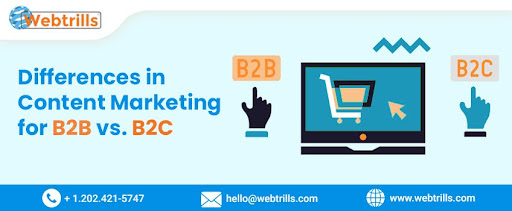






It stems from how content marketing is effective in helping businesses reach their audiences, develop confidence, and eventually convert them. Although content marketing aims to provide value to its target audience, the approaches and methods adopted in B2B and B2C contexts are vastly divergent. For this reason, differences are observed in terms of target consumers, decision-making, and even the nature of commodities or services being offered for consumption. Onto the disparities unique to B2B and B2C content marketing, our Search Engine Marketing Company Ashburn USA is here to tell you about both the differences and relevance of the former to the latter.
B2B: Business-to-business (B2B) content marketing is aimed at other companies, their executives and executives, employees, and buyers like big procurement officers and managers. These people are expected to make decisions on productivity, revenue, and development of their organization. As a result, B2B decisions are assumed to be highly rational and based on ROI, emphasizing research, analysis, and approval. The main emphasis is on developing long-term cooperation and trust with the help of values-oriented content.
B2C: B2C marketing differs from B2B marketing in that consumer marketing is aimed at individual consumers who make their decisions individually and are influenced by their emotions, perceptions, and needs bound by time. Therefore, Purchasing decisions take less time depending on satisfying factors such as time, cost, and product brand image. In contrast to the B2B form that focuses on developing strategic relationships that produce long-term contracts, the B2C content marketing targets creating an impulsive need and forcing immediate action on the clients.
- B2B: The success of B2B content marketing is evaluated by the indicators associated with the sales funnel and leads. Key performance indicators (KPIs) include:
Number of Qualified Leads created.
- Click through and open rates for the emails that have been sent.
- Number of people who signed up for each webinar and the total number of participants.
- The target is focused on users’ time spent on detailed content such as white papers.
The main emphasis is on capturing interaction along the buyer funnel, starting when a client becomes aware of the product.
- B2C: In B2C, the metrics focus on impressions, likes and followers, and conversions or sales. Common KPIs include:
- Website traffic and bounce rates
- Likes, tags, shares, and posts comments.
- The two most important key performance indicators are conversion rates and average order value.
- Customer reviews and ratings.
These are the obvious top-line effects of content on consumers as it targets fast results.
B2B: Business-to-business Content Marketing Company fits in a complex sales funnel where leads are further engaged after the initial interaction. Content is carefully tailored to each stage:
Awareness: Site articles, industry articles, and social media posts.
Consideration: Webinars, white papers, and case studies.
Decision: Recommended readings include word of mouth, product presentations, and post-purchase calculations.
Following these structures guarantees that the target customers are given the right information at a specific time to build trust and confidence gradually.
B2C: B2C business sales funnels are usually much simpler and highly targeted singular business deals centered around amusement. Information often links the awareness and decision-making stages to optimize the conversion rate. For example:
- A live advert placed on a social networking site may display a product but have a ‘Click here to shop’ button.
- Partnerships with influencers can lead to rapid credibility-building and sales simultaneously.
B2B: Any B2B Content Marketing Company usually entails time and money into deep and focused assets including industry study, evaluation of analytic data, and expertise content. To develop comprehensive white papers, business-like webinars, and niche e-mail promotions, money is spent.
B2C: A more tactical B2C budget is split for creative campaigns, influential spreads, and paid social media. It is more centered on creating visually appealing imagery by posting informative and entertaining short content suitable for all users.
B2B: The language used in B2B content is serious, business-like, and backed by statistics. It relies on rationality; a hallmark of this communication style is a reference to the principles of operation, industry standards, surveys, and various examples from the field of activity. The tone is accordingly formal and, wherever possible, prescriptive for readers familiar with the companies and their markets.
B2C: While B2C content is quite formal, it is more conversational, businesslike, and emotionally appealing. Sometimes, it relies on emotions – mainly, storytelling and humor - and direct language to affect consumers. It is lively and innovative, which carries the image and outlook of the target group.
B2B: The primary entertainment medium for B2B marketers is platforms and formats that appeal to business people. These include:
LinkedIn: Perfect for disseminating information professionally on new articles, industry news, and updates. You can take the help of SMO Services Company Ashburn USA for the same too.
Email campaigns: Their key aim is target audience, lead nurturing, and Content Marketing Services.
Industry blogs: Presenting materialized, tailor-made, detailed addresses on subjects of interest to the receiver.
Webinars: A common goal of these communities of practice is to offer opportunities for cooperative learning and business networking.
This type is also important in the strategies with its audience since reports and guides always come in handy in satisfying the need for elaborated data.
B2C: In large part, B2C marketing is based on engaging, simple, and, as often as possible, content posted on heavily trafficked sites such as:
Instagram: Lifestyle photography, reels, influencers, etc.
Facebook: For posts, ads, and community building.
TikTok: How trends and short videos can be utilized to win young audiences' generation.
YouTube: Displaying tutorials, reviews, and product demonstrations.
Short-form content, including memes, videos, and social media posts, is also popular in B2C marketing because it captures attention due to its small size.
B2B: The main goal of B2B Content Marketing Services is to provide useful information so that the target can view the brand as an authoritative voice of reason in the line of business. The leads can be nurtured through detailed information and the best practices given herein through long sales cycles.
B2C: In B2B, the purpose is mostly strategic and, therefore, usually not to entertain, inspire, or solve any immediate issues. It goes straight to the audience's feelings and gives them something to take for the brand. Business-to-consumer content is more about achieving small wins, making a sale, encouraging an impulse buy, and building customer loyalty.
The common principles of a content marketing strategy for B2B and B2C companies are the same, but some differences must be effected. But in the Business-to-Business context, content marketing is about providing value through thorough, serious, and statistically informative pieces that build relationships and support the prospect sales funnel longer cycles. Conversely, B2C marketing aims to capture emotional aspects, make quick decisions, and use bright and vivid content to act immediately. For more information or to avail services of our Content Marketing Services company in Ashburn Virginia, visit Webtrills.com!

